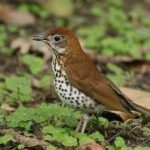
Wood Thrushes have just arrived in our yard in North Carolina, having completed their migration from Central America that began a few weeks ago. Their flutelike singing from the treetops affirms that spring is really here.
Recognizing that it is part of our nation’s heritage, the Wood Thrush is one of about 1000 species that have been protected by the Migratory Bird Protection Act (MBPA) of 1918. Even with that protection the population of Wood Thrush is down about 60 percent from a few decades ago. The species is sensitive to acid rain, house cats, habitat destruction, and collisions with buildings and automobiles.
The Migratory Bird Protection Act was no doubt stimulated by the extinction of the Passenger Pigeon, for which the last individual died in the Cincinnati Zoo in 1914. Even with the protection of the MBPA, North America is estimated to have lost 3 billion members of its avian populations in the past half-century. Many species have lost 20 to 50 percent of their population, with grassland species the hardest hit.
This loss of birds matters. Through observation and field experiments, we know that birds feed on a variety of insects that are harmful to crops and forests. Their loss translates to direct economic losses for humans. Indirectly, birds pump money into local economies through the activity of hunters and birdwatchers, who constitute some of the largest recreational groups in the nation.
Even so, a couple of years ago, at the urging of the oil and gas industry, the Trump administration announced that the U.S. Department of Interior would no longer enforce penalties for incidental killing of birds—only intentional killing. If I were to shoot a Wood Thrush from the treetop, I could be prosecuted under the MBPA. If I were a land developer and bulldozed the woodland for a new treeless suburban development, I would be forgiven if I inadvertently destroyed a few Wood Thrush nests.
Vacating the provisions for incidental death of birds would have exempted British Petroleum from fines associated with bird deaths from the Deep-Water Horizon oil spill and Exxon-Mobil from the Valdez disaster. The argument goes that we must not let birds stand in the way of the economic development of this country, especially the pursuit of energy resources.
Of course, with his aggravating level of thoughtless inconsistency, the President has criticized wind mills for their incidental effects on birds—overlooking a recent analysis by the Ecological Society of America that this source of mortality is rather trivial for bird populations and central to our efforts to mitigate the ongoing changes in climate.
Birds matter. And with proper regulations for their protection and the judicious development of new sources of energy, we can have both for a bright future.
References:
Ecological Society of America. 2019. Impacts to wildlife of wind energy siting and operation in the United States. https://www.esa.org/wp-content/uploads/2019/09/Issues-in-Ecology_Fall-2019.pdf
Hames, R.S., K.V. Rosenberg, J.D. Lowe, S.E. Barker, and A.A. Dhondt. 2002. Adverse effects of acid rain on the distribution of Wood Thrush (Hylocichla mustelina) in North America. Proceedings of the National Academy of Sciences 99: 11235-11240.
Karp, D.S., C.D. Mendenhall, R.F. Sandi, N. Chaumont, P.R. Ehrlich, E.A. Hadly and C.C. Daily. 2013. Forest bolsters bird abundance, pest control and coffee yield. Ecology Letters 16: 1339-1347.
Mantyla, E., T. Klemola, and T. Laaksonen. 2011. Birds help plants: a meta-analysis of top-down trophic cascades caused by avian predators. Oecologia 165: 143-151.
Rosenberg, K.V. et al. 2019. Decline of the North American avifauna. Science 366: 120-124.
Rushing, C.S., T.B. Ryder, and P.P. Marra. 2016. Quantifying drivers of population dynamics for a migratory bird population throughout the annual cycle. Proceedings of the Royal Society of London B 283: doi: 10.1098/repb.2015.2846